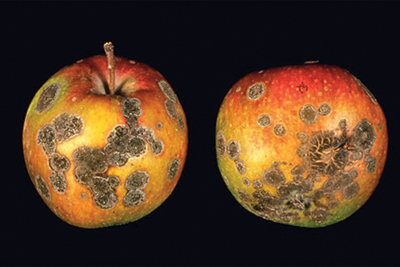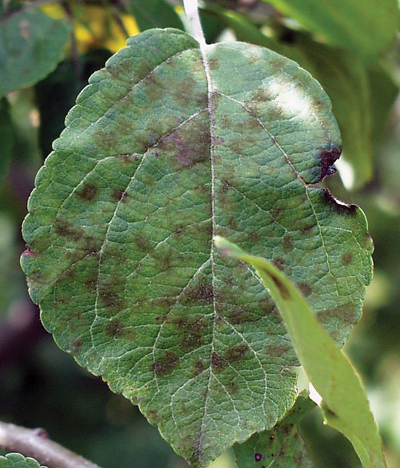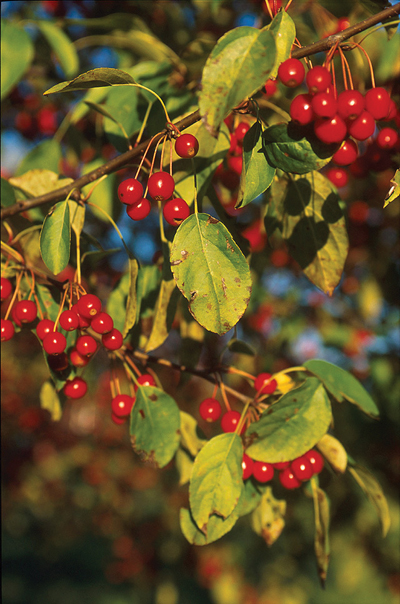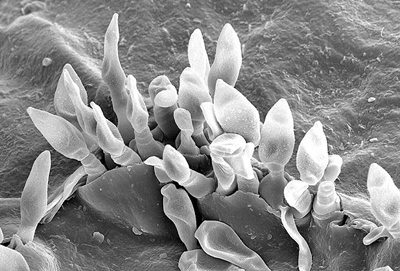
Good and vigilant management is needed to address apple scab and the potential for resistance to fungicides says Dr. Wendy McFadden-Smith, tender fruit and grape specialist with the Ontario Ministry of Agriculture, Food and Rural Affairs (OMAFRA).

|
|
| Symptoms of apple scab on fruit. Photo courtesy of the American Phytopathological Society |
|

|
|
| Symptoms of apple scab on a leaf. Photo courtesy of South Dakota State University. | |

|
|
| Symptoms of apple scab on crabapple. | |

|
|
| Fungal spores that cause apple scab disease (Venturia inaequalis) erupting through the cuticle of a crabapple leaf.
|
Good and vigilant management is needed to address apple scab and the potential for resistance to fungicides says Dr. Wendy McFadden-Smith, tender fruit and grape specialist with the Ontario Ministry of Agriculture, Food and Rural Affairs (OMAFRA).
“Pretty well everyone had some scab this year (2008),” she says. “It was always raining or it was too windy. It was very difficult to spray.”
The incidence of apple scab in Ontario has been steadily increasing over the past five years; for example scab in packout from orchards in Eastern Ontario rose from 1.4 per cent in 2002 to six per cent in 2007.
Fungicide resistance should be a major concern for all growers and, once established, apple scab populations are permanent. Fungicide timing is also very important, otherwise the resistance problems in the U.S. could develop here, Dr. McFadden-Smith says.
The development of the apple scab fungus’s resistance to benomyl was unexpected and sudden in the U.S. It took only one mutation to allow it to spread rapidly through orchards, she explains.
Resistance to multi-site fungicides, such as thiram, ferbam, sulphur, copper, mancozeb and polyram, is extremely unlikely, Dr. McFadden-Smith says, adding but for all other fungicides, resistance has developed.
Research was conducted in 16 Ontario orchards from 1999 to 2000 to test for apple scab tolerance to demethylation inhibiting (DMI) fungicides such as Nustar and Nova. Isolates of the apple scab fungus were collected and screened by mounting them on agar plates with and without a discriminatory dose of myclobutanil. Resistant isolates grew as well on amended plates as on the unamended agar. According to a formula developed by Dr. Wolfram Koeller of Cornell University, once 43 per cent of the isolates from an orchard are tolerant of the discriminatory dose, practical resistance is present. This means that the labeled rate of the DMI fungicide no longer provides control of apple scab. In 1999, none of the orchards were even close to having practical resistance. In the 2007 survey, three of the orchards were “resistant.”
Dr. Koeller also determined that practical resistance will start to develop in an orchard after approximately 60 applications. This assumes excellent coverage, proper spray intervals and no sprays applied after lesions have developed.
Dr. McFadden-Smith collected spray records from the orchards where she sampled. From 1992 to 1999, the most sprays applied by a cooperator over the entire seven-year study period was 33. Ontario growers also applied DMI fungicides in a tank mix with a protectant and did not apply them after first cover, both important factors in reducing resistance pressure.
“While peak scab spore release occurs at bloom, green tip is the time to spray,” explains Dr. McFadden-Smith “Green tip infections can produce lesions that can infect fruits at petal fall. If a leaves are protected from green-tip, the chances of having sporulating lesions when fruit are young and very susceptible to infection will be much less.”
Dr. Mcfadden-Smith suggests growers use mancozeb or a copper spray, adding that Captan would also work too but growers would have to watch for phytotoxicity with dormant oils.
Dr. McFadden-Smith says growers should be conservative in orchards with high levels of inoculum present over winter, using the label rate and a tight spray schedule from silver tip through petal fall. For suppression of overwintering disease inoculum, she suggests they consider a ground spray of urea in the fall or early spring.
She also suggests nor more than two DMI or strobilurin sprays be used in one year. The sprays should also not be used after lesions occur.
Always follow the instructions on the label and be aware of what is going on in your orchard, Dr. McFadden-Smith reminds, adding spray coverage is generally the worst at the top of the tree and apple scab can often develop there first.
Print this page